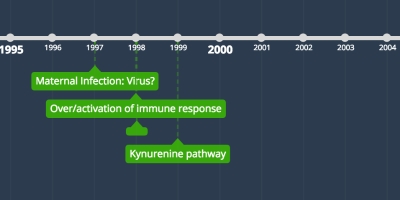jan 2, 1999 - Kynurenine pathway
Description:
Microglia activation can alter tryptophan metabolism in the kynurenine pathway, producing metabolites that behave as (NMDAR)-agonists (quinolinic acid) or antagonists (kynurenic acid, or KYNA) (Khandaker et al, 2015; Meyer et al, 2011; Moller et al, 2012). NMDAR dysfunction is associated with schizophrenia (Bressan et al, 2003) and NMDAR-antagonists have been shown to induce schizophrenia-like symptoms in healthy volunteers, similar to (Gouzoulis et al, 2005).Some pro-inflammatory cytokines that have been shown to be elevated as a result of infection have also been linked to the Kynurenine pathway and elevated levels of kynurenic acid (KYNA) (Urata et al., 2014; Sellgren et al., 2015; Schwieler et al., 2015). In regards to the cytokine IL-1β, it has been shown that the secretion of IL-1β induced the rate-limiting enzyme tryptophan 2,3-dioxygenase-2 (TDO2) in the kynurenine pathway, which caused an elevation in brain kynurenic acid (Sellgren et al., 2015) and IL-1β also increased the expression of TDO and thereby stimulated tryptophan catabolism to increase kynurenine production (Urata et al., 2014). The cytokine IL-6 has also been shown to play a role in the kynurenine pathway and a study demonstrated
a positive correlation between CSF IL-6 and the production of KYNA in patients with schizophrenia as reflected by a decreased tryptophan:KYNA ratio (Schwieler et al, 2015).
Added to timeline:
Date:
jan 2, 1999
Now
~ 25 years ago

